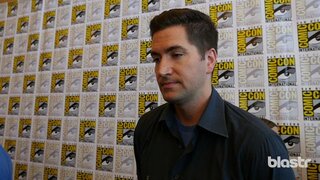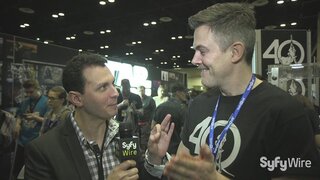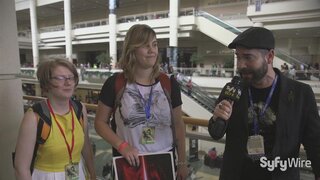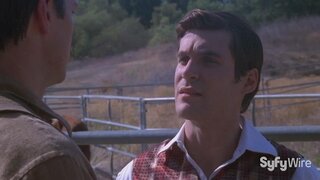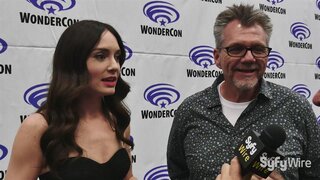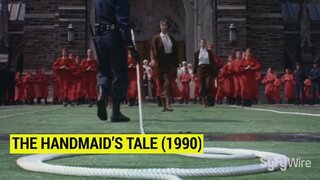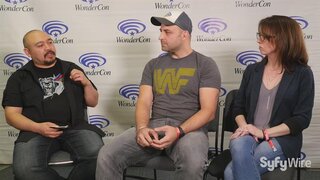16 Years Ago: Cloverfield Was a Monster of a Mystery From J.J. Abrams and Matt Reeves
Remembering one of J.J. Abrams' original mystery box movies.
There is value, one would argue, in mystery, in intrigue, and in surprise. If you do it correctly, anti-marketing — the Beyoncé-style surprise album drop — can be the best marketing possible. And this was perhaps never truer than with the release of Cloverfield, which came out on Jan. 18, 2008. The movie (airing on SYFY this weekend) is now known as a phenomenon, one that launched two more movies and countless theories and discussions.
But when it came out, it felt like it had landed out of nowhere. It felt like something we had all individually discovered. It felt new.
Why Was Cloverfield a Big Deal?
The first trailer for Cloverfield wasn't a trailer at all. It simply featured footage, seemingly from a camcorder, of some sort of explosive, terrifying event in New York City and a gaggle of good-looking young urbanites scrambling to get away. It was attached to Transformers in the summer of 2007 and didn't even have a title. But the trailer also got around online, particularly around the blogs of the time; Defamer, the Hollywood offshoot of Gawker, said the trailer had audiences "scratching their heads" but also implored readers to find any information about the movie that they could. There was just a spare website, 1-18-08.com, providing little but promising so much more.
RELATED: The Best Sci-Fi Movies on Peacock
By the time the movie came out, all the online sleuths — who had figured out the movie's name, and that it was a J.J. Abrams project — weren't just watching a movie: They were taking part in a project in which they felt like they had ownership. It made the movie, in a fashion not entirely dissimilar to The Blair Witch Project, feel like something you'd stumbled across, something you individually had discovered... something that was real. That it had a then-unknown cast — though we'd all end up knowing Lizzy Caplan and T.J. Miller — made it feel even more like a home movie starring us and our friends. That this illusion persisted even though the movie was about a monster attacking New York City showed just how powerful it was.
The Impact of Cloverfield
Ordinarily, movies released in January are dumping-ground movies, films that studios thought couldn't hold a key calendar spot in the summer or fall, and they are reviewed accordingly: Critics generally have their guards up. But Cloverfield earned excellent notices immediately; while making sure to warn audiences that the found-footage shaky-cam technique could induce nausea, critics pointed out just how effective a thriller it was. Roger Ebert even noted that it got away with some explicit references to 9/11 without any pushback, pointing out "the statute has run out on the theory that after 9/11 it would be in bad taste to show Manhattan being destroyed." It helped that, as he noted, it was "actually pretty scary."
And audiences liked it even more. This "little" found footage movie, with a cast of nobodies and a budget that roughly covered the catering for a Transformers movie, fulfilled the promise of online marketing that had fallen short for, say, Snakes on a Plane a little over a year earlier. The movie was an instant smash, bringing in $40.1 million its opening weekend, the largest opening weekend for a January release ever. It would end up grossing more than $170 million, an incredible number for a brand-new property that no one in the world had heard about only a few months earlier.
RELATED: Watch Cloverfield Airing This Weekend on SYFY
And that was just the start. The movie, in addition to launching the career of director Matt Reeves (who would make the fantastic Let Me In, two Planet of the Apes, and The Batman), ended up establishing a franchise of its own, spinning off a larger Cloverfield universe, with 10 Cloverfield Lane and The Cloverfield Paradox coming years later. The irony was clear: The anti-franchise film created a franchise of its own.
Does Cloverfield Hold Up?
The movie makes a big deal out of trying to be as "modern" as possible. (I can say, as a young New Yorker in 2008 who went to a ton of crowded rooftop parties, it sure gets that part right.) But while the people and the parties still feel familiar today, the technology has clearly changed dramatically. In the film, Miller's character has to keep coming up with excuses for why he's still filming. There would be no such issue today: Every character in the film would be constantly filming everything. There also would be much less confusion: Twitter would update everyone on the monster's movements.
But watching the movie still, somehow, feels like something you are discovering — like something that is happening in real-time. When you saw this in the theater, you couldn't help but connect it to the marketing, which was designed specifically to make you feel that way. But that it still works in that fashion more than a decade later speaks to the quality of the film itself, the way that Reeves plunges you into the action and yet provides a logical escalation throughout. The best scene may still be the news footage when we realize there are insect-like creatures falling off the monster that can kill us: Wait, they can do that, too?
That's what made the movie work then, and that's what makes it work now. And, tellingly, it's why the sequels/spinoffs provided diminishing returns. Similar marketing techniques were employed; the mystery, the confusion, but not only were the movies themselves not as good (particularly the third film, which may have killed the franchise entirely), but there was nothing new to discover about them. They all had to tie into the original film. We couldn't discover them. They belonged to someone else, something larger, not us. They were just... another franchise.
Will Leitch is the co-host of The Grierson & Leitch Podcast, where he and Tim Grierson review films old and new. Follow them on Twitter or visit their site.
Cloverfield is airing this weekend on SYFY. Check out the SYFY schedule for exact air dates to catch the monster movie classic.
Originally published Jan 20, 2021.

